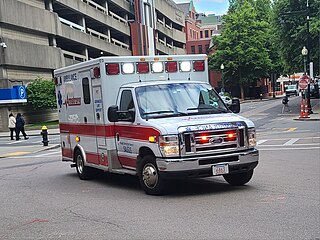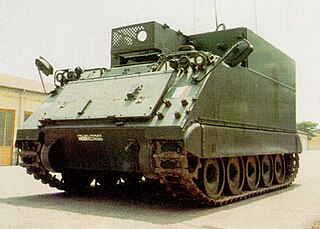
An ambulance is a medically-equipped vehicle used to transport patients to treatment facilities, such as hospitals. Typically, out-of-hospital medical care is provided to the patient during the transport. Ambulances are used to respond to medical emergencies by emergency medical services (EMS), and they are generally considered emergency vehicles authorized to be equipped with flashing emergency lights and sirens. They can rapidly transport paramedics and other first responders to the scene, carry equipment for administering emergency care and transport patients to hospital or other definitive care. Most ambulances use a design based on vans or pickup trucks, though others take the form of motorcycles, buses, limousines, aircraft and boats.

The M113 is a fully tracked armored personnel carrier (APC) that was developed and produced by the FMC Corporation. The M113 was sent to United States Army Europe in 1961 to replace the mechanized infantry's M59 APCs. The M113 was first used in combat in April 1962 after the United States provided the South Vietnamese army (ARVN) with heavy weaponry such as the M113, under the Military Assistance Command, Vietnam (MACV) program. Eventually, the M113 was the most widely used armored vehicle of the U.S. Army in the Vietnam War and was used to break through heavy thickets in the midst of the jungle to attack and overrun enemy positions. It was largely known as an "APC" or an "ACAV" by the allied forces.
Talha is an armoured personnel carrier (APC) designed and manufactured in Pakistan by APC Factory of Heavy Industries Taxila (HIT).

The AIFV is a US tracked light armored vehicle that serves as an infantry fighting vehicle (IFV) in the armies of several countries. It is a development of the M113A1 armored personnel carrier.
A huge number of M113 Armored Personnel Carrier variants have been created, ranging from infantry carriers to nuclear missile carriers. The M113 armored personnel carrier has become one of the most prolific armored vehicles of the second half of the 20th century, and continues to serve with armies around the world in many roles.

The NM135 Stormpanservogn is a Norwegian tracked light armoured vehicle (LAV). It is variant of the American M113 armoured personnel carrier (APC), armed with a 20mm cannon in a rotating turret.

An armoured personnel carrier (APC) is a broad type of armoured military vehicle designed to transport personnel and equipment in combat zones. Since World War I, APCs have become a very common piece of military equipment around the world.
The Egyptian Infantry Fighting Vehicle (EIFV), also known as Infantry Fighting Vehicle Light (IFVL), is an Egyptian modification of the M113. It is a hybrid, based on an enlarged M113 chassis equipped with the complete two-man power-operated turret of the M2 Bradley IFV. The EIFV never entered production for Egyptian Army.

The Manned Ground Vehicles (MGV) was a family of lighter and more transportable ground vehicles developed by BAE Systems and General Dynamics as part of the U.S. Army's Future Combat Systems (FCS) program. The MGV program was intended as a successor to the Stryker of the Interim Armored Vehicle program.

The Didgori-I is an armoured multi-role and special operations vehicle produced by STC Delta. It was developed in 2009 alongside the Didgori-2 using the same internal features with some additional functions. The armoured personnel carrier is thought to provide transport, enhanced visibility and firepower support for infantry troops and Special Forces in various missions including reconnaissance and convoy protection.
The Northern Army Group (NORTHAG) was a NATO military formation comprising five Army Corps from five NATO member nations. During the Cold War NORTHAG was NATO's forward defence in the Northern half of the Federal Republic of Germany (FRG). The Southern half of the Federal Republic of Germany was to be defended by the four Army Corps of NATO's Central Army Group (CENTAG). During wartime NORTHAG would command four frontline corps and one reserve corps. Air support was provided by Second Allied Tactical Air Force.

The Armored Multi-Purpose Vehicle (AMPV) is a U.S. Army program to replace the M113 armored personnel carrier and family of vehicles. AMPV is a sub-project of the Next Generation Combat Vehicle program.

The Type 08 is a family of eight-wheeled amphibious, modular armored vehicle developed by Norinco for infantry fire support, battlefield logistics, and quick reaction operations. Developed in the early 2000s, the modern Chinese vehicle family were produced for more than 6000 hulls and widely deployed by the People's Liberation Army Ground Force and People's Liberation Army Marine Corps.

The Didgori Medevac is a Georgian-made medical armoured personnel carrier developed by the "Delta" research center of the Ministry of Defence of Georgia and part of the Didgori-series APC family currently constructed in five baseline variants.

Lynx is a series of lightweight all-terrain vehicle with 8x8, 6x6, or 4x4 all wheel drive. The vehicle is amphibious and capable of center-turning. Militarized version were observed in 2008 with reinforced chassis, weapon mounts, storage space and roll cage. The vehicle has different layout for different mission set, including troop transport, logistics, heavy weapon platform, reconnaissance, air defense, engineering service, or medical evacuation. During airborne, quick reaction and special forces operations this vehicle can be launched by tactical airlift or transport helicopters, or helicopter sling load.
The M113A4 Armored Medical Evacuation Vehicle (AMEV) is a U.S. Army variant of a M113 armoured personnel carrier (APC) made by United Defense modified to function as a battlefield emergency medical evacuation (medevac) vehicle. It replaced the M113A3 Armoured Ambulance in U.S. military service and is designed to operate in conjunction with the M577A4 Armored Treatment Vehicle.

The M577 Command Post Carrier, also known as the M577 Command Post Vehicle or Armored Command Post Vehicle, is a variant of the M113 Armored Personnel Carrier that was developed and produced by the Food Machinery and Chemical Corporation (FMC) to function on the battlefield as a mobile command post i.e. a tactical operations centre, usually at the battalion level. In U.S. military service its official designation is Carrier, Command Post, Light Tracked M577.

The PMMC G5 is a family of light tracked vehicles designed and manufactured by Flensburger Fahrzeugbau GmbH (FFG) of Germany. Although it is similar in appearance and design to the American M113, and the company manufacturers modernised versions of that vehicle, the PMMC G5 is an all-new ground-up design.













